Nutrient Film Technique
Nutrient Film Technique, commonly known as NFT, is a highly efficient and popular method of hydroponic gardening. This technique involves a continuous flow of nutrient-rich water over the roots of plants, which are housed in channels or tubes. Its popularity stems from its simplicity, space efficiency, and the ability to provide plants with constant access to nutrients, water, and oxygen.
As one of the more commonly used systems for hobbyists, NFT systems operate through a combination of optimal nutrient delivery and efficient oxygenation. Inside the channel, the roots of the plants hang suspended, partially submerged in the nutrient solution. This setup ensures that the lower portion of the roots absorbs water and nutrients, while the upper part remains exposed to air, absorbing oxygen. The enclosed, dark environment of the channel mimics (and enhances) a natural environment, where the cool, dark conditions of soil are simulated.
This article delves into the depths of NFT systems, covering their designs, considerations, advantages, disadvantages, and the essential materials required to get started. Whether you are a seasoned hydroponic farmer or a beginner interested in sustainable gardening practices, this guide offers comprehensive insights into the world of NFT hydroponics.
Table of Contents:
- NFT System Designs
- NFT Considerations
- NFT Advantages and Disadvantages
- Materials to Get Started
- What You Can Grow
- FAQs
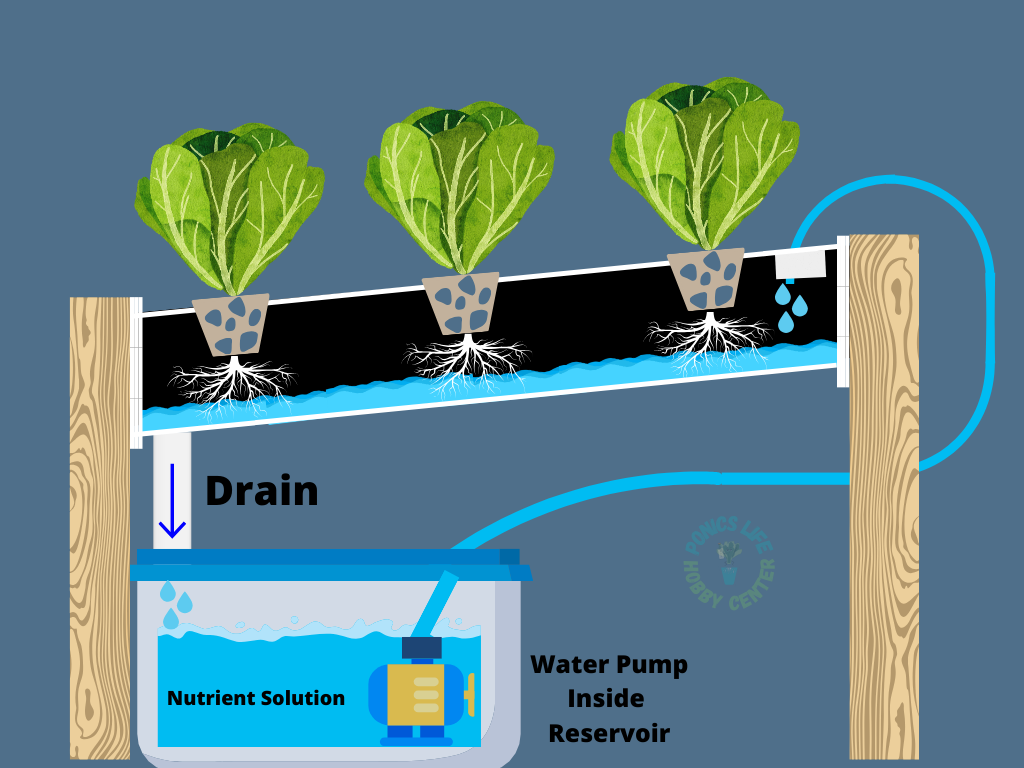
NFT System Designs
There are thousands of different ways to design NFT systems, but there are two popular methods that are generally considered to be the most efficient and adaptable for hobbyists: a horizontal NFT and vertical NFT system.
Vertical NFT Systems
Vertical NFT systems are space-efficient and ideal for urban areas. They involve stacking channels vertically, allowing for a larger number of plants in a smaller footprint. However, they require careful attention to water distribution and may be more difficult to maintain overall.
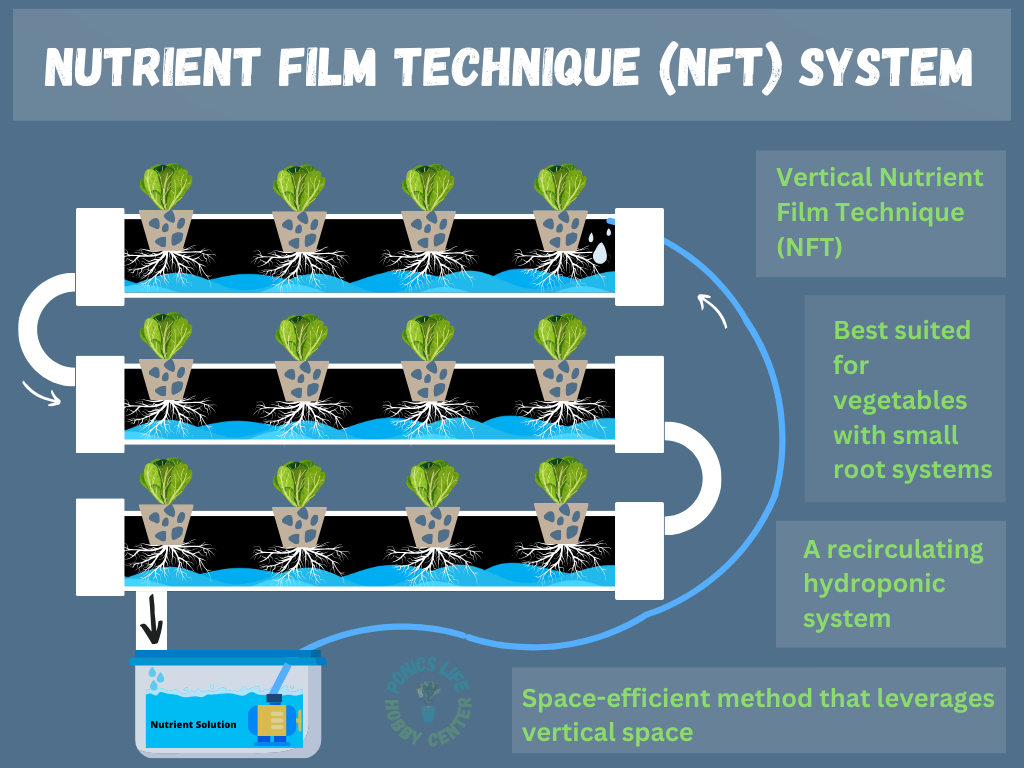
Horizontal NFT Systems
Horizontal NFT systems are more common and easier to construct, making them ideal for beginners and hobbyists. They facilitate easier monitoring and maintenance of plants. The horizontal layout ensures uniform water flow but requires sufficient space.
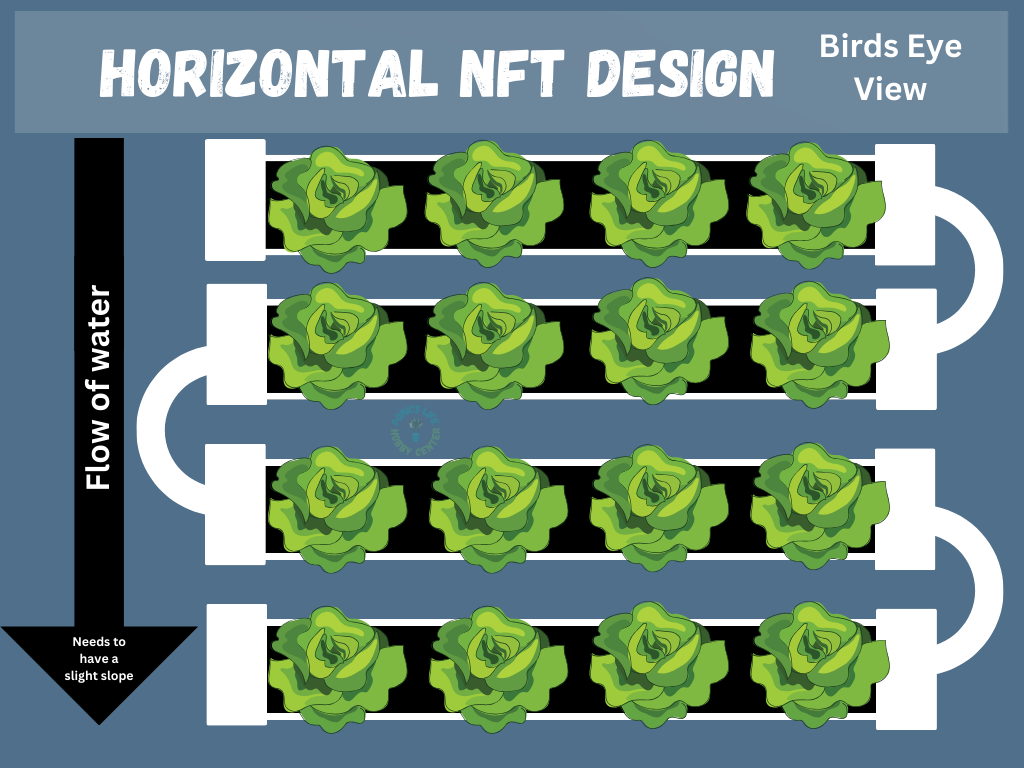
Other Variations
NFT systems are adaptable, with variations including multi-layered setups and hybrid systems combining NFT with other hydroponic methods. Innovations like secondary nutrient feed lines in longer channels or incorporating smart technology for monitoring are also emerging. These variations cater to different space constraints, plant types, and grower preferences.
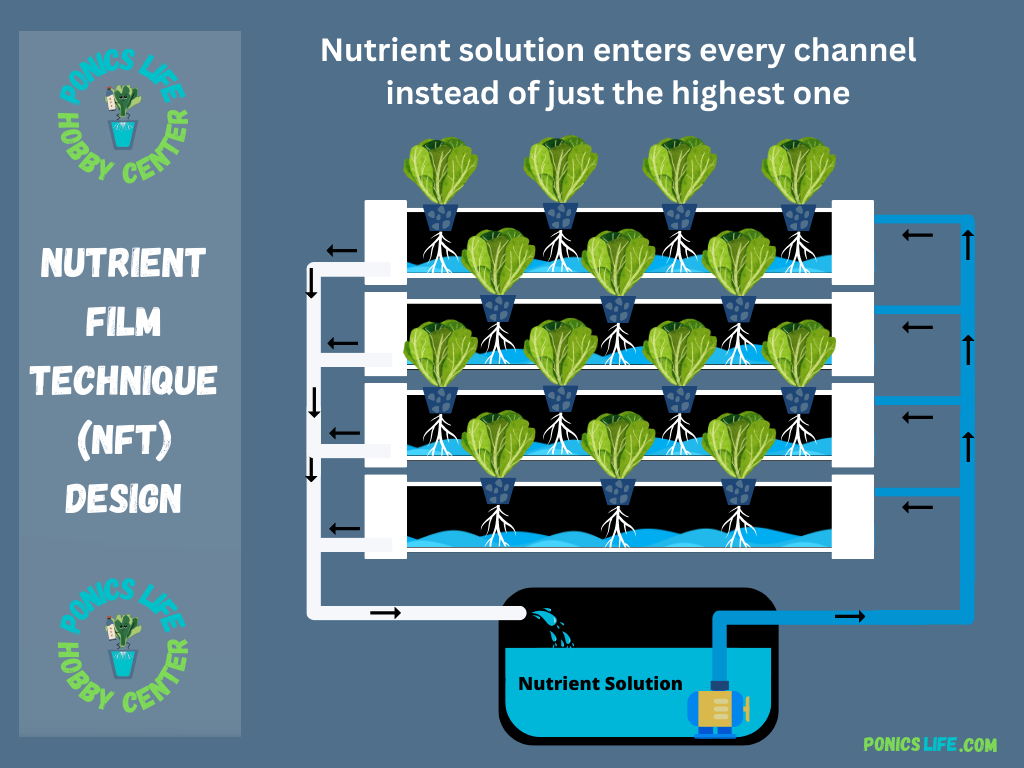
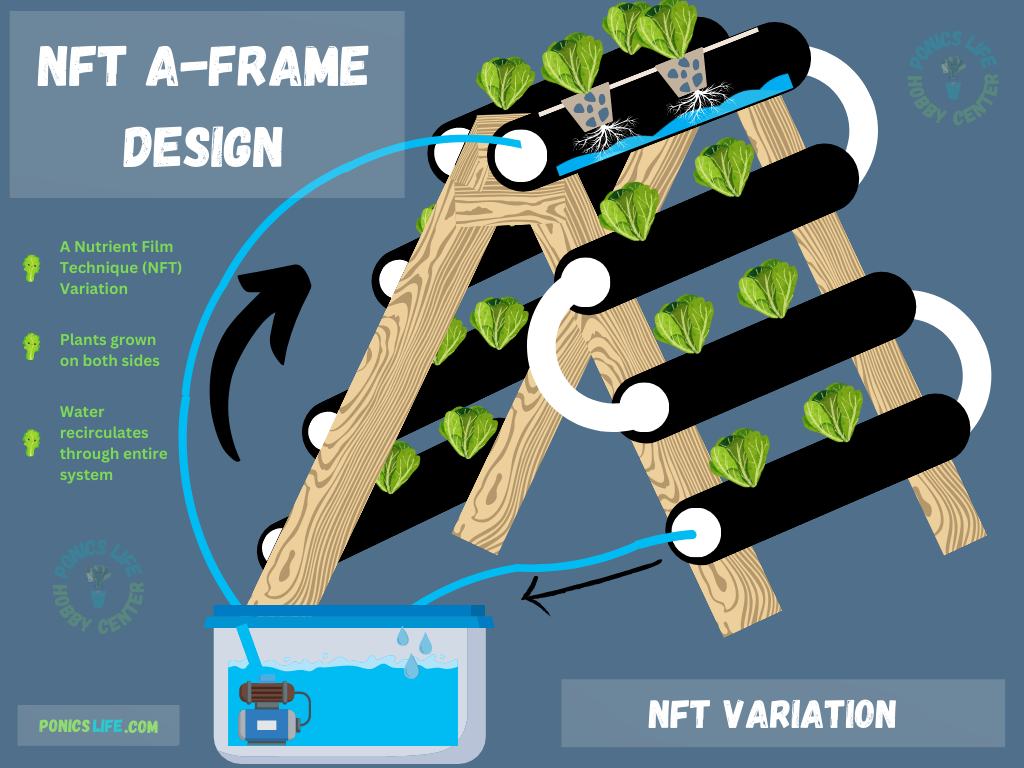
Nutrient Film Technique Considerations
Delving into the specifics of the Nutrient Film Technique, it’s crucial to consider several key aspects that directly influence the success of your hydroponic system. From the intricate process of transferring seedlings to choosing the right environment, and from optimizing flow rate and slope to selecting the appropriate channel shape, each element plays a vital role in the efficiency and productivity of your NFT setup.
Transferring Seedlings
While some designs allow you to start seeds directly in your system, most do not. If your design is of the latter, transfer your seedlings when they have a few true leaves and have a somewhat distinguishable root system. When you place them into your system, you want the bottom of your roots to make contact with the nutrient solution in the channel. Otherwise, they likely won’t survive.
Indoors or Outdoors
Choosing the right environment for your NFT system is crucial. Indoors offers control over climate, pests, and lighting, suitable for year-round growing. Outdoors utilizes natural light and can be cost-effective, but it’s more vulnerable to weather changes and seasonal limitations.
Flow Rate and Slope
The flow rate and slope of an NFT system are crucial for optimal plant growth. While it’s best to do your own trial and error testing, we recommend a slope ratio of between 1:30 to 1:40 (1-inch drop per 30 inches of length and a 1-inch drop per 40 inches of length). This will prevent pooling and ensure steady water movement and good aeration. The recommended flow rate ranges between 1/4 to 1/2 gallon (1 to 2 liters) per minute per channel (15 gallons to 30 gallons per hour (60 to 120 liter’s)) adjustable based on plant size and development stages (seedlings typically need a slower flow than mature plants).
Round vs Square Channels
Round channels, like uPVC or ADS tubing, are cost-effective and suitable for home systems, though they may require a steeper slope for efficient water flow. Square or flat-bottom channels, often used commercially, sometimes feature grooves for better water distribution and root support. The choice between round and square channels depends on budget, space, and specific plant requirements.
Length of NFT Channel
The length of the NFT channel plays a significant role in nutrient distribution and plant health, and if it’s too long, you may see plants on one end lacking nutrients. Channels typically range from a few feet to up to 40 feet, with longer channels requiring additional (aka secondary) nutrient feed lines to prevent deficiencies. It’s important to balance channel length with the system’s capacity to maintain consistent nutrient flow and avoid water pooling.
Water Depth of NFT System
In NFT systems, maintaining a shallow water depth, typically just a millimeter or two, is key for effective nutrient delivery and oxygenation. This depth allows roots to wick up moisture while preventing saturation. And while there are some designs that may have a couple inches of water (in which it becomes somewhat of a DWC/NFT hybrid), you never want the water to fill up your entire channel.
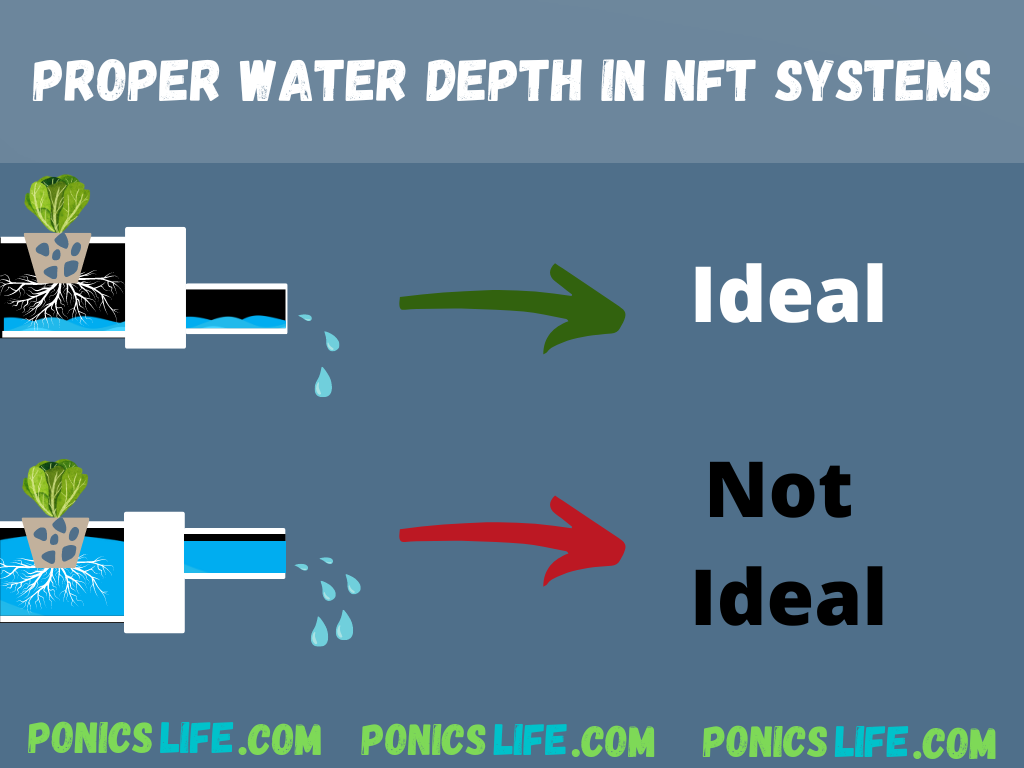
Advantages and Disadvantages
Exploring the pros and cons of the Nutrient Film Technique (NFT) is essential for anyone interested in this hydroponic method. While NFT offers several benefits, including space efficiency and reduced growing media needs, it also presents unique challenges, such as high setup costs and system maintenance.
Advantages
- Ideal for Vertical Growth: NFT is unparalleled for vertical hydroponic plant cultivation, making it a space-saving and efficient option for urban farming and small spaces.
- Reduced Growing Media Needs: The reliance on minimal growing media, primarily just used in net pots, simplifies setup and reduces some costs.
- Easy Root Monitoring: The system design allows for straightforward observation of root health, enabling timely intervention if needed.
- Water Efficient: Like other hydroponic systems, NFT setups are generally more efficient in terms of water use compared to traditional soil-based gardening, as the water continually recirculates.
- Enhanced Aeration: The thin film of nutrient solution in NFT systems ensures ample oxygen supply to the roots, crucial for healthy plant growth.
- Optimal Nutrient Absorption: NFT provides consistent nutrient delivery to the roots, leading to efficient and uniform absorption, vital for optimal plant development.
Disadvantages
- Not Suitable for Slow-Growing Plants: NFT systems may not be the best choice for slower-growing plants, as they may require a longer period to establish a sufficient root system.
- Critical Slope Requirement: Getting the slope of the channels right is crucial; incorrect slopes can lead to water pooling or insufficient flow, impacting plant growth.
- Risk of Clogging from Large Roots: Plants with extensive root systems, like tomatoes or cucumbers, can obstruct water flow, leading to maintenance challenges and potential system failure.
- Maintenance of Moving Parts: NFT systems contain several moving components like pumps and channels that require regular upkeep.
- Higher Initial Setup Cost: Compared to other hydroponic systems like Deep Water Culture or Ebb and Flow, the initial investment for NFT can be higher due to its complexity and the materials needed.
Materials Needed
To set up a successful Nutrient Film Technique (NFT) system, selecting the right materials is crucial. Each component plays a vital role in ensuring the system operates efficiently and supports healthy plant growth. Here’s a breakdown of the essential materials needed for building an NFT system:
Channels
Channels are the backbone of the NFT system, where plants are placed and the nutrient solution flows. They should be made of durable, non-toxic material like uPVC, ADS tubing, or food-grade plastic (more on plastics in the FAQ section). The size and shape of the channels can vary based on personal preference and the space available, but most hobbyists builds are around 4 inches in diameter (at a minimum).
Net Cups and Grow Medium
Net cups hold the plants and allow roots to access the nutrient film. They should be appropriately sized for the plants and fit snugly into the channels (usually a 2 inch or 3 inch net cup will work). A lightweight, inert grow medium like coco coir chips or clay pebbles is used in these cups to support the plants, provide initial moisture, and facilitate root growth. Learn more about net cups here and grow mediums here.
Reservoir
The reservoir stores the nutrient solution. It should be large enough to hold a sufficient volume of solution for your system size and made of a material that doesn’t leach chemicals/microplastics into the solution. Dark materials (aka opaque materials) or covered reservoirs are preferable to prevent algae growth.
Water Pump
Water pumps circulate the nutrient solution from the reservoir to the channels. They need to be powerful enough to ensure a consistent flow rate suitable for your system’s size. Ensure the pump can handle continuous operation and is compatible with the nutrient solution. In most hobby setups, an aquarium or pond pump will work just fine.
Air Pumps (Optional)
If you find that NFT channels have a few inches of water (rather than a couple millimeters as recommended) you can try adding an air pump and air stone to your reservoir. This will add additional oxygen to the nutrient solution, enhancing root health.
Timer (optional)
Timers automate the nutrient solution flow, making the system more efficient and energy conscious. They are especially useful in larger systems or for growers who want a more precise nutrient solution/oxygenation ratio. The on/off timing will depend on your specific setup (and is indeed a trial and error process), but ensure the timer is compatible with your pump and can handle the electrical load.
Misc. Connections
This includes all the pipes, tubes, fittings, and connectors needed to link the reservoir, channels, and pumps. They should be durable, not clear (to precent algae), and sized appropriately for your system’s layout. Leak-proof and easy to assemble connections are preferable for long-term reliability. If you’re growing indoors, you’ll likely need to use glue or adhesive (that’s safe for potable water) to prevent leaks.
Nutrients
Nutrients are essential for plant growth in NFT systems. Choose a proven hydroponic nutrient formula that’s suitable for the types of plants you’re growing. You can learn more about nutrients in hydroponic systems here.
What You Can Grow
It’s important to understand that NFT systems do have limitations, particularly when it comes to the types of crops they can support. While ideal for herbs and shallow root vegetables, their design is less suited for larger, deep-rooted plants that require more substrate support and space to thrive.
Growing Herbs
The Nutrient Film Technique is exceptionally well-suited for cultivating a variety of herbs. Herbs like basil, mint, and parsley thrive in this system, benefiting from the constant flow of nutrient-rich water which promotes lush, aromatic growth. The NFT system’s ability to maintain optimal nutrient levels and oxygenation ensures that these herbs develop healthy and flavorful.
Shallow Root Vegetables
Due to the space constraint of NFT channels (whether round or square), it’s best to grow shallow root vegetables. Vegetables like lettuce, green onions, celery, spinach, and radishes will thrive in an NFT system as their roots will have plenty of room to spread out. These vegetables flourish in the shallow, nutrient-rich film of water that NFT provides, offering an ideal balance of hydration and aeration crucial for quick and robust leaf growth.
Medium to Large Root Vegetables
When it comes to medium to large root vegetables like broccoli, tomatoes, and cucumbers, the NFT system faces certain limitations. These vegetables require a depth and stability of medium that NFT can’t typically provide due to their larger root systems and longer growing times (although some NFT channels are large enough). While NFT is excellent for many types of crops, growers interested in these larger root vegetables might need to consider other hydroponic setups, like deep water culture (DWC) or ebb and flow (flood and drain) systems, which can better accommodate the needs of these plants.
FAQs
Do I need to also oxygenate the reservoir?
NFT systems naturally oxygenate plant roots through the air gap between the bottom of the plant and the nutrient film, as well as through the falling water’s movement back to the reservoir. Generally, it’s not necessary to add extra oxygenation with an air pump and air stone. However, if you observe signs of oxygen deficiency in your plants, such as drooping, adding additional oxygenation can be beneficial.
How do I start seeds in my NFT system?
Most NFT systems are not designed for direct seed starting, as they typically have only a thin film of water at the channel’s base, insufficient for germination. It’s advisable to start seeds separately in a moist environment and transfer them to the NFT system once they’ve developed a substantial root system that can reach the nutrient solution.
What kind of plastic is safe for NFT systems?
For NFT systems, using safe plastics is crucial. Most channels are constructed using PVC. As of this writing, there’s no direct study on the effects of specific plastics in NFT systems, but it’s recommended to use uPVC or other food-safe, BPA-free plastic materials to ensure safety and durability. You can read more on food safe plastics here.
Can NFT systems leak indoors?
Leaks in NFT systems can occur, typically due to unsealed connections or root blockages in the channels. To mitigate this, ensure all connections are properly sealed with a potable water-rated sealant, choose plants with suitable root sizes, and regularly inspect and clean the channels to prevent clogging.
Can the roots cause a dam?
Indeed, overly large root systems can obstruct water flow in NFT channels, acting like a dam. To prevent this, it’s important to select plants with appropriate root sizes for your channel dimensions and regularly maintain the system to ensure unobstructed flow.
How often should I change the water in the reservoir?
You’ll want to change the reservoir water about every 2 to 3 weeks. When changing, try to give your reservoir a good cleaning as well.
Is NFT growing a strict science?
No, there is no perfect way to design or grow in an NFT system and it’s important to do your own trial and error. Depending on what you’ve built, you may find that things work for you differently (slope, length, etc.). What’s important is that you learn from your mistakes and adjust as needed.
Are there other hydroponic systems?
There are 6 basic types of hydroponic systems: The Wick System, Deep Water Culture, Ebb and Flow (Flood and Drain), Nutrient Film Technique, the Drip System, and Aeroponics. There is also the Kratky Method which is a fun system to explore.
I’m new to hydroponics, is there a good resource out there?
Yes, explore our hydroponics hobby center here, or you can download our Beginners eBook below. Both are great resources that will set you up for success.






